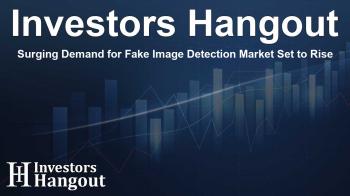Surging Demand for Fake Image Detection Market Set to Rise

The Booming Fake Image Detection Market: A Look Ahead
In today’s digital landscape, the ability to distinguish real images from manipulated ones is increasingly critical. The rise in fake content has become a pressing concern for various sectors, and the demand for effective fake image detection tools has surged dramatically. According to recent research, the global fake image detection market is expected to reach an astounding value of $4.9 billion by the year 2030, blossoming from an estimated $0.6 billion in 2024. This growth reflects a compound annual growth rate (CAGR) of 42%, underscoring the urgency for reliable technology in safeguarding information integrity.
Transformative Market Dynamics Driving Growth
The explosive growth of the fake image detection market can be attributed to several key factors. First and foremost, the escalating volume of digital content—over 300 million images uploaded daily on popular social media platforms—demonstrates an increasing need for accurate detection tools. The rapid evolution of technology, including machine learning and cloud-based artificial intelligence, greatly enhances detection capabilities, enabling sectors like government, healthcare, and e-commerce to implement these solutions efficiently.
Technological Advancements Fueling Detection Accuracy
Technological innovations, particularly in deep learning and neural networks, have revolutionized image detection accuracy. Studies conducted at esteemed institutions have shown that detection tools can now achieve precision as high as 95%, enabling the identification of subtle anomalies that suggest photo tampering. Such advancements have made these tools indispensable for businesses and organizations aiming to preserve their credibility and user trust.
Regulatory Pressures to Enhance Compliance
The regulatory landscape is also shifting, with the enactment of laws mandating platforms to implement fraudulent image detection mechanisms. The Digital Media Integrity Act is one such regulation driving this urgent need. As governments and industry organizations work towards establishing universal standards, compliance will likely create a myriad of new business opportunities alongside fostering ethical practices within the space.
Challenges in the Fake Image Detection Landscape
Despite the favorable market conditions, companies face notable challenges, especially concerning privacy and data security. Consumer apprehension over how their data is used and the risk of data breaches are significant hurdles. Companies in the fake image detection sector must prioritize privacy-conscious designs and transparent data handling processes to earn consumer trust. Implementing measures such as on-device image processing and encryption will be essential.
Sector Analysis and Market Segmentation
The fake image detection market spans various applications, including social media moderation, fraud detection, and healthcare imaging. The market is segmented by offerings such as solutions (including deepfake detection and real-time verification tools) and services (consulting and support). Additionally, companies will tailor their offerings catering to individual professionals and large-scale enterprises.
Regional Insights and Competitive Landscape
Geographically, North America holds a significant share of the fake image detection market, projected to maintain its dominance throughout the forecasting period. Companies such as Microsoft, Google, and BioID are leading the charge in developing cutting-edge solutions, alongside emerging players that also contribute to this dynamic market landscape. Collaborative efforts among these technological pioneers will likely accelerate developments and innovations in image detection.
Conclusion: Navigating the Future of Fake Image Detection
The fake image detection sector is poised for rapid expansion, driven by advances in technology, rising content moderation needs, and evolving regulatory pressures. As organizations recognize the imperative of maintaining user trust, investments in detection solutions will continue to rise. Adapting to these changes by embracing innovative tools and ethical standards will ensure stakeholders stay ahead in this fast-evolving market.
Frequently Asked Questions
What factors are driving the growth of the fake image detection market?
The growth is driven by the rising volume of digital content and technological advancements in machine learning and AI that enhance detection accuracy.
Which sectors are adopting fake image detection technologies?
Key sectors include government, healthcare, e-commerce, media, and telecommunications.
What are the major challenges in this market?
Challenges include privacy concerns, data security, and consumer trust issues regarding data usage.
Who are the key players in the fake image detection market?
Leading players include Microsoft, Google, BioID, and emerging companies in the tech field.
What is the expected market size by 2030?
The fake image detection market is projected to exceed $4.9 billion by 2030.
About The Author
Contact Logan Wright privately here. Or send an email with ATTN: Logan Wright as the subject to contact@investorshangout.com.
About Investors Hangout
Investors Hangout is a leading online stock forum for financial discussion and learning, offering a wide range of free tools and resources. It draws in traders of all levels, who exchange market knowledge, investigate trading tactics, and keep an eye on industry developments in real time. Featuring financial articles, stock message boards, quotes, charts, company profiles, and live news updates. Through cooperative learning and a wealth of informational resources, it helps users from novices creating their first portfolios to experts honing their techniques. Join Investors Hangout today: https://investorshangout.com/
The content of this article is based on factual, publicly available information and does not represent legal, financial, or investment advice. Investors Hangout does not offer financial advice, and the author is not a licensed financial advisor. Consult a qualified advisor before making any financial or investment decisions based on this article. This article should not be considered advice to purchase, sell, or hold any securities or other investments. If any of the material provided here is inaccurate, please contact us for corrections.

